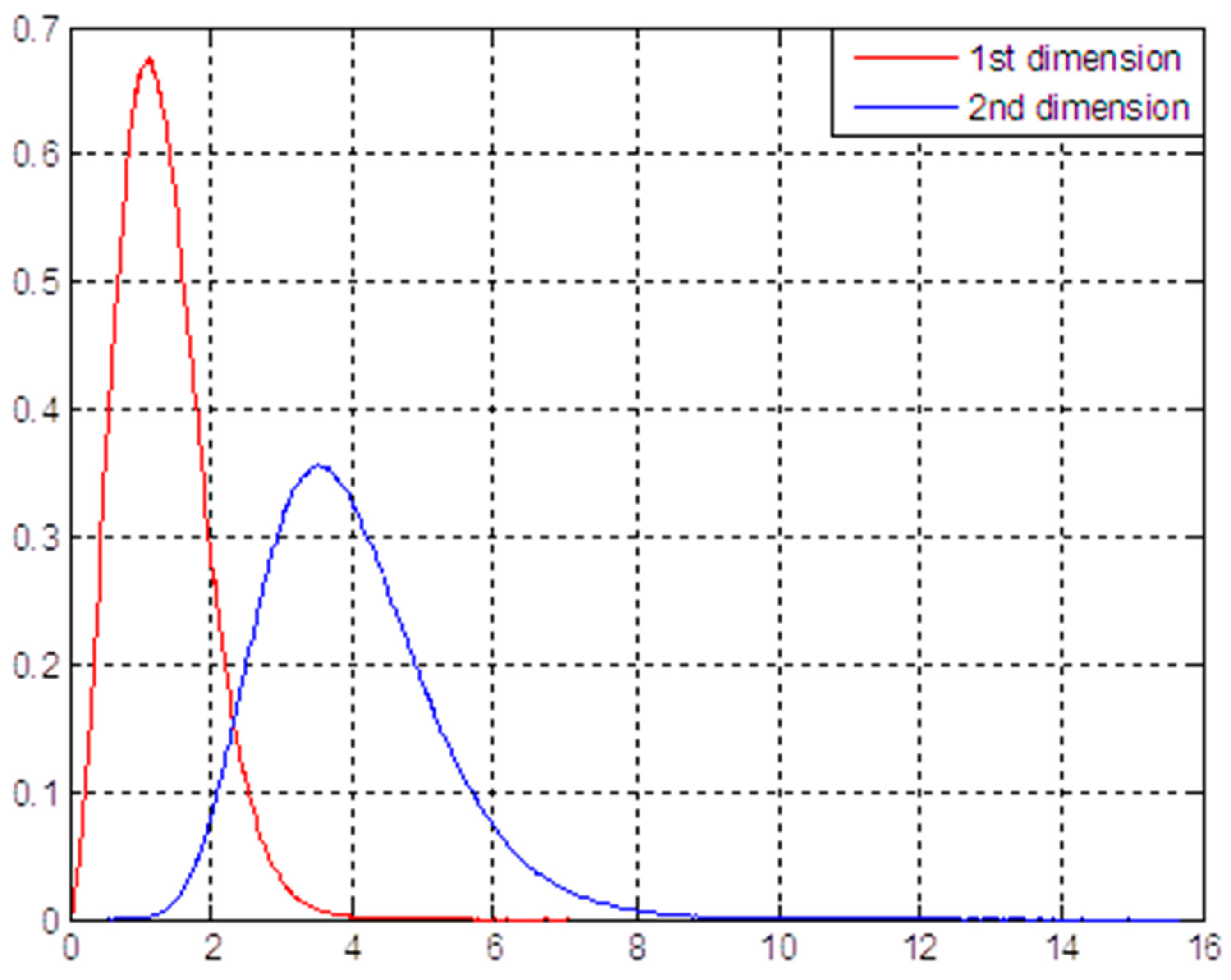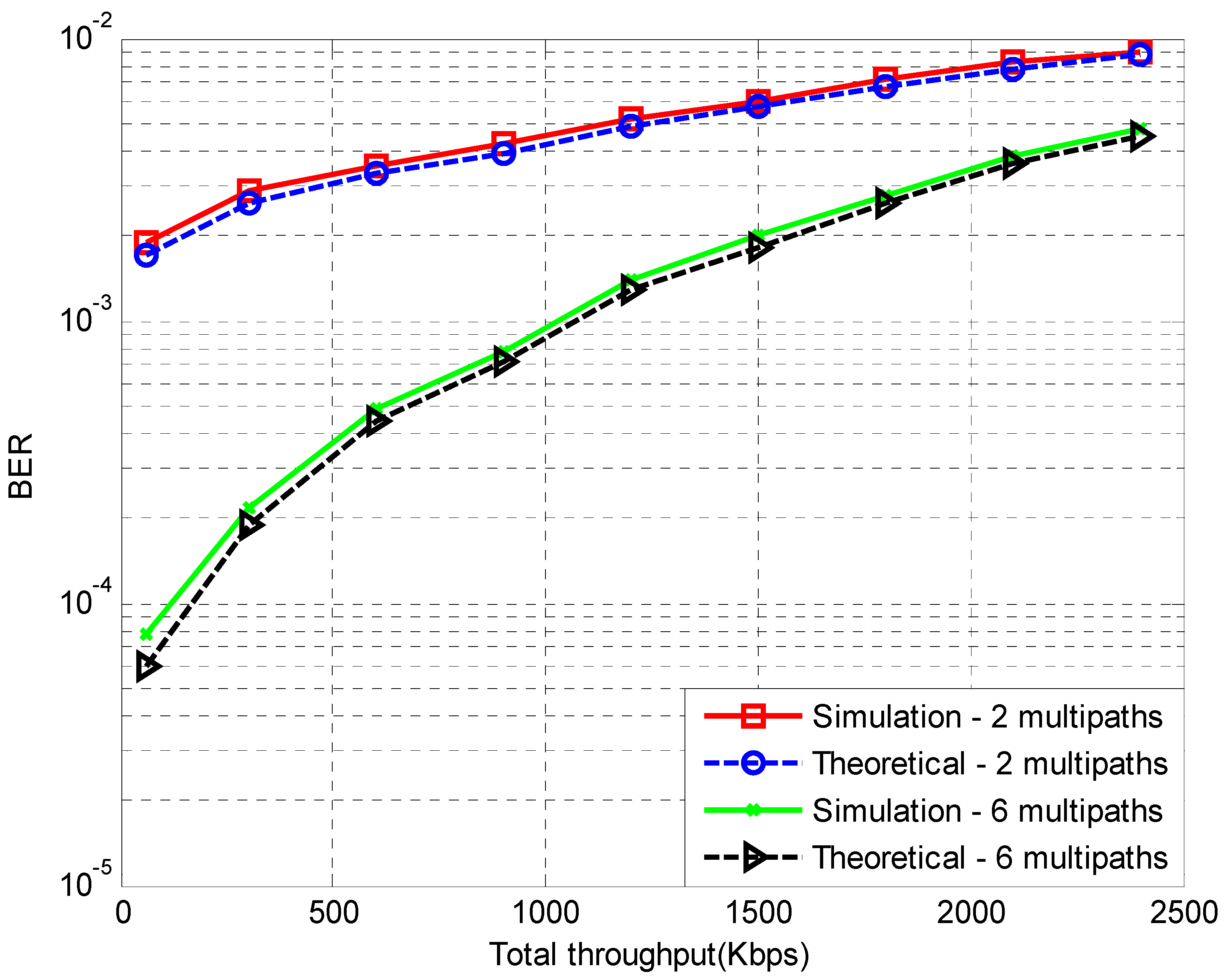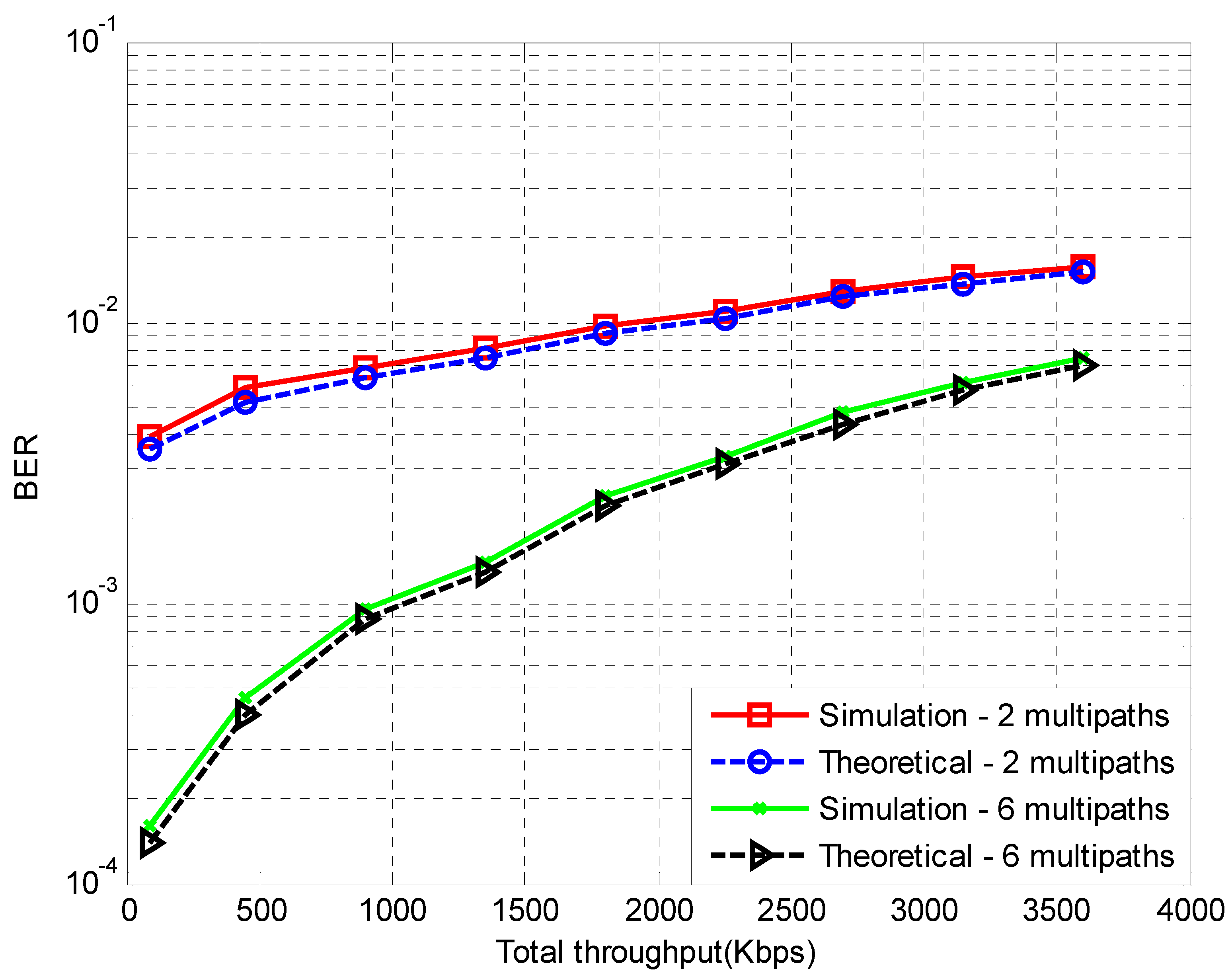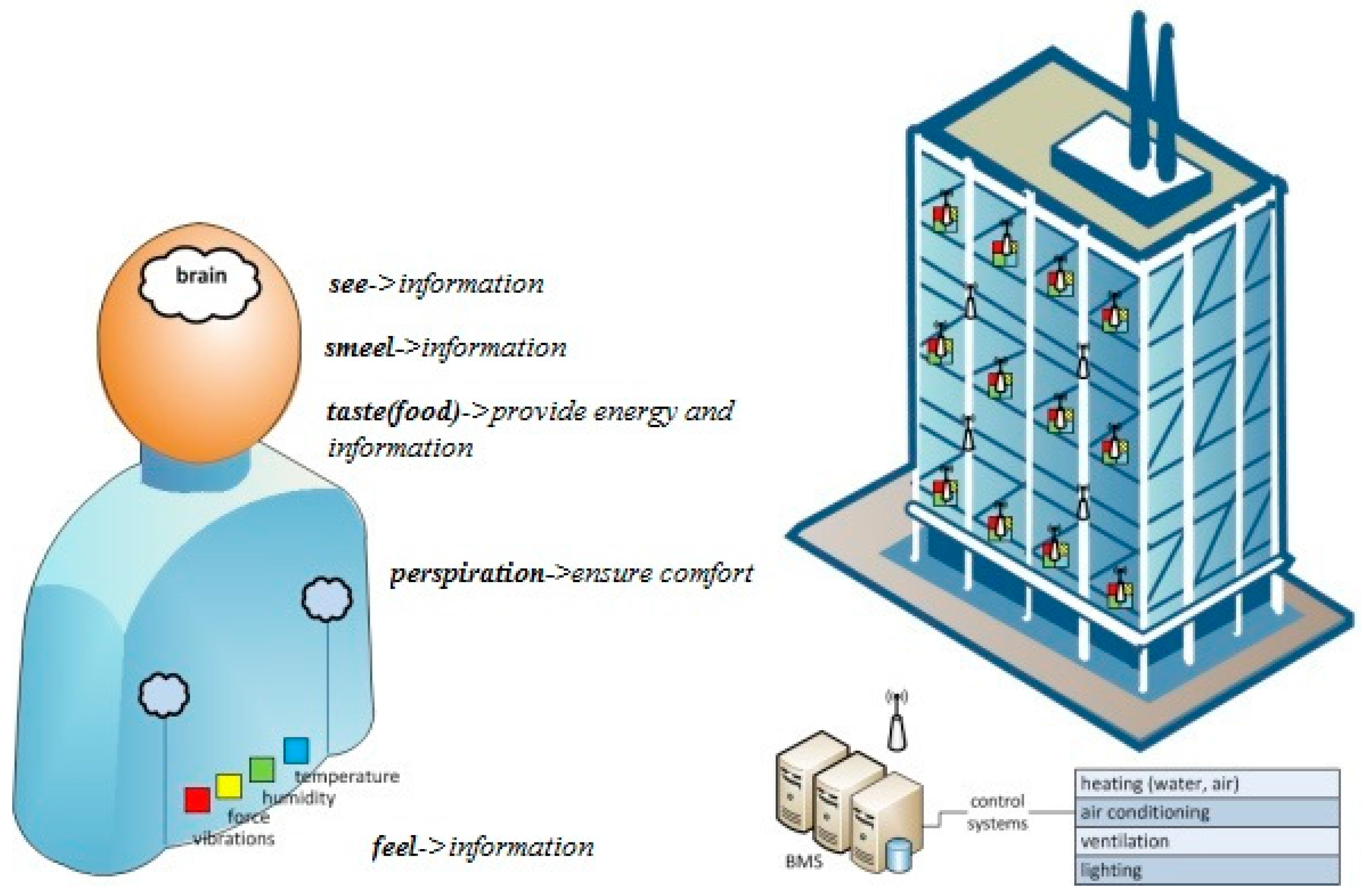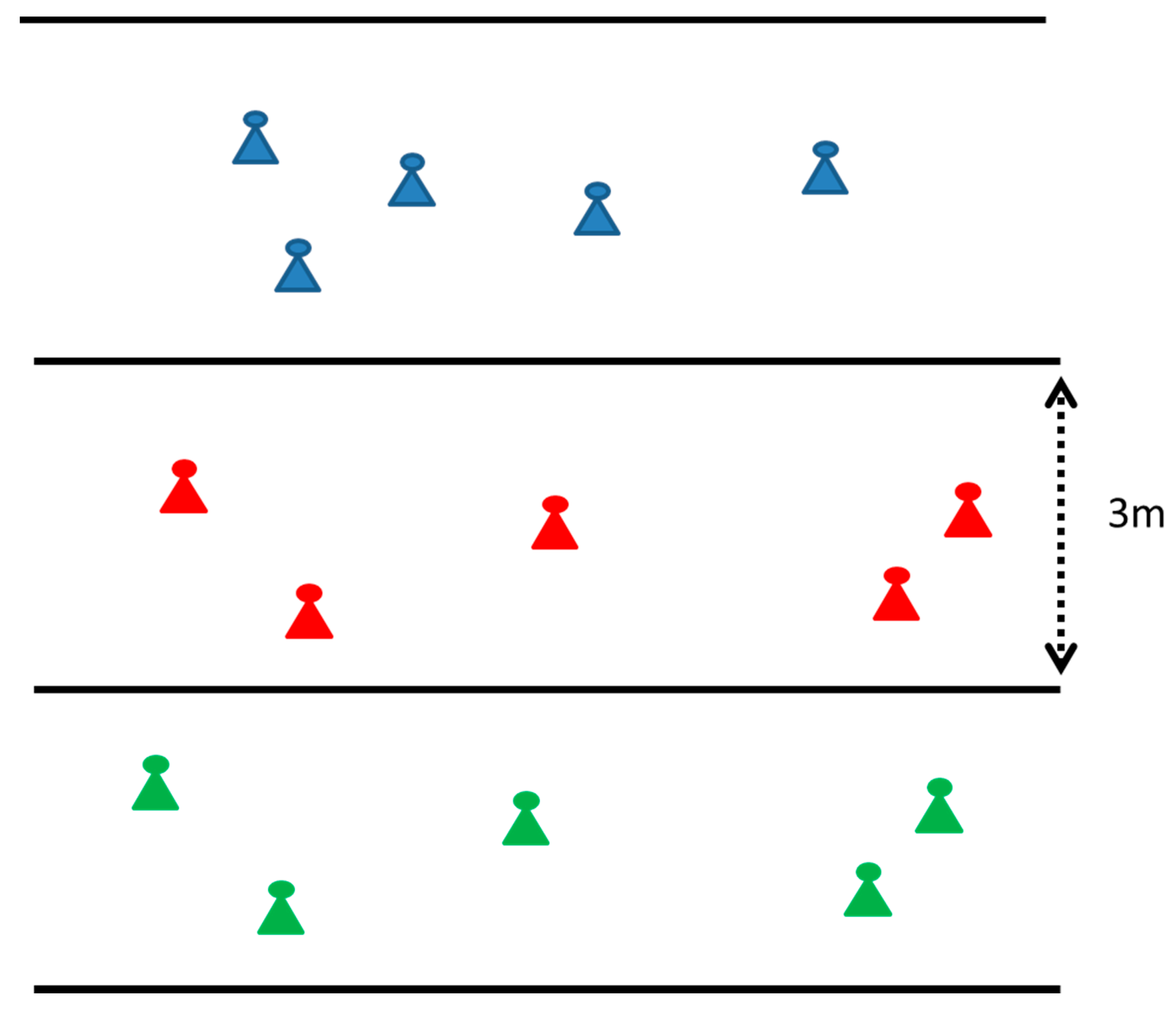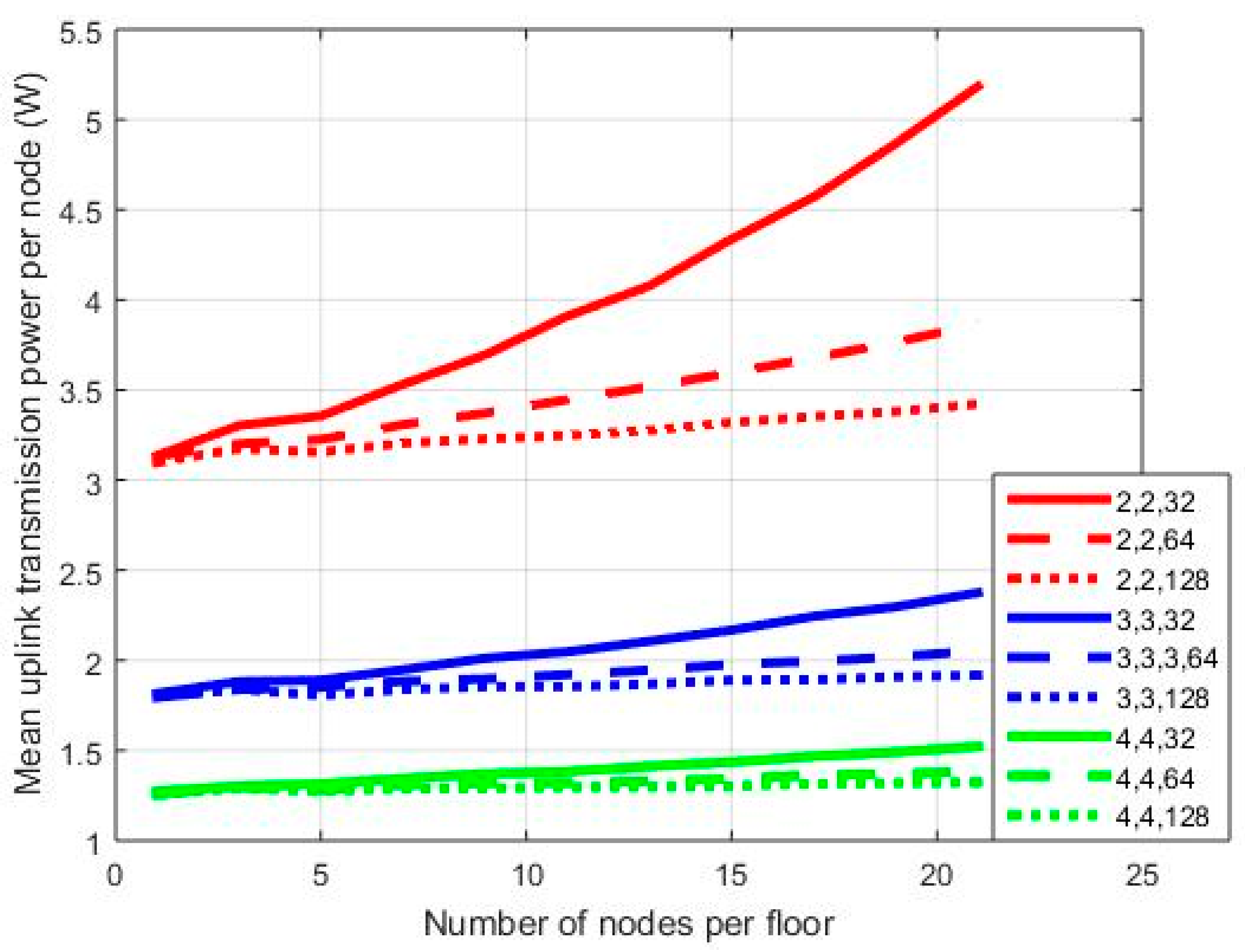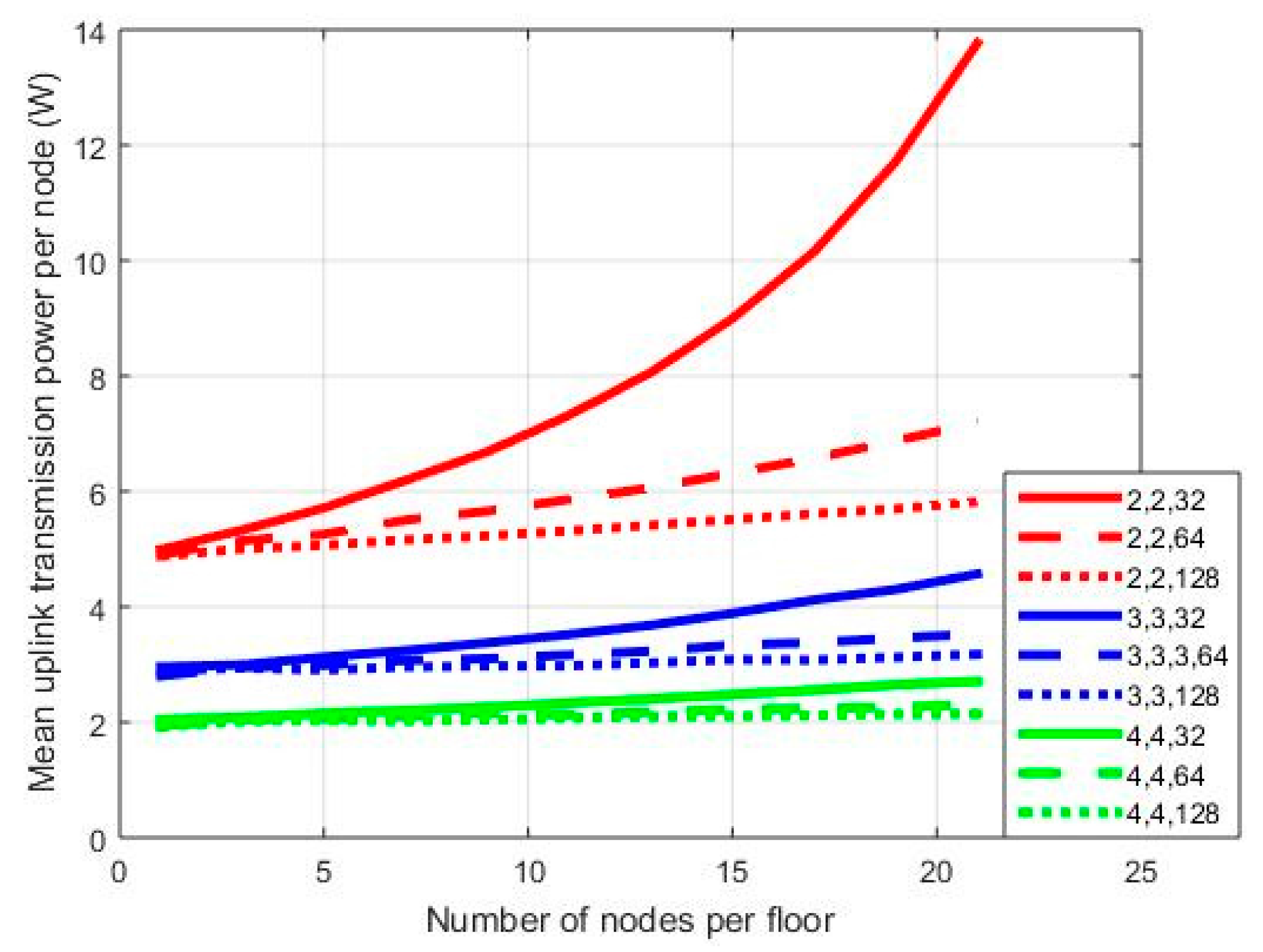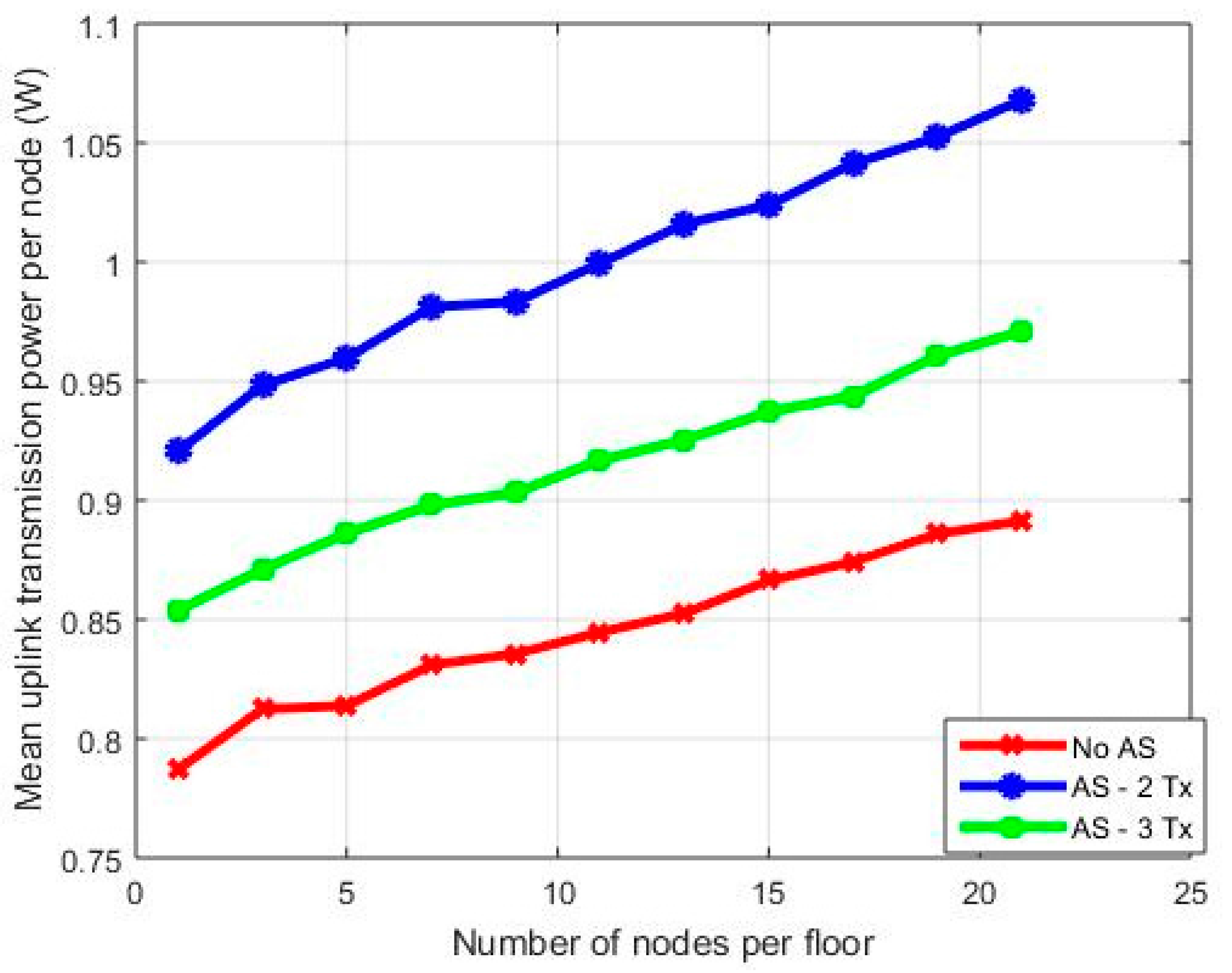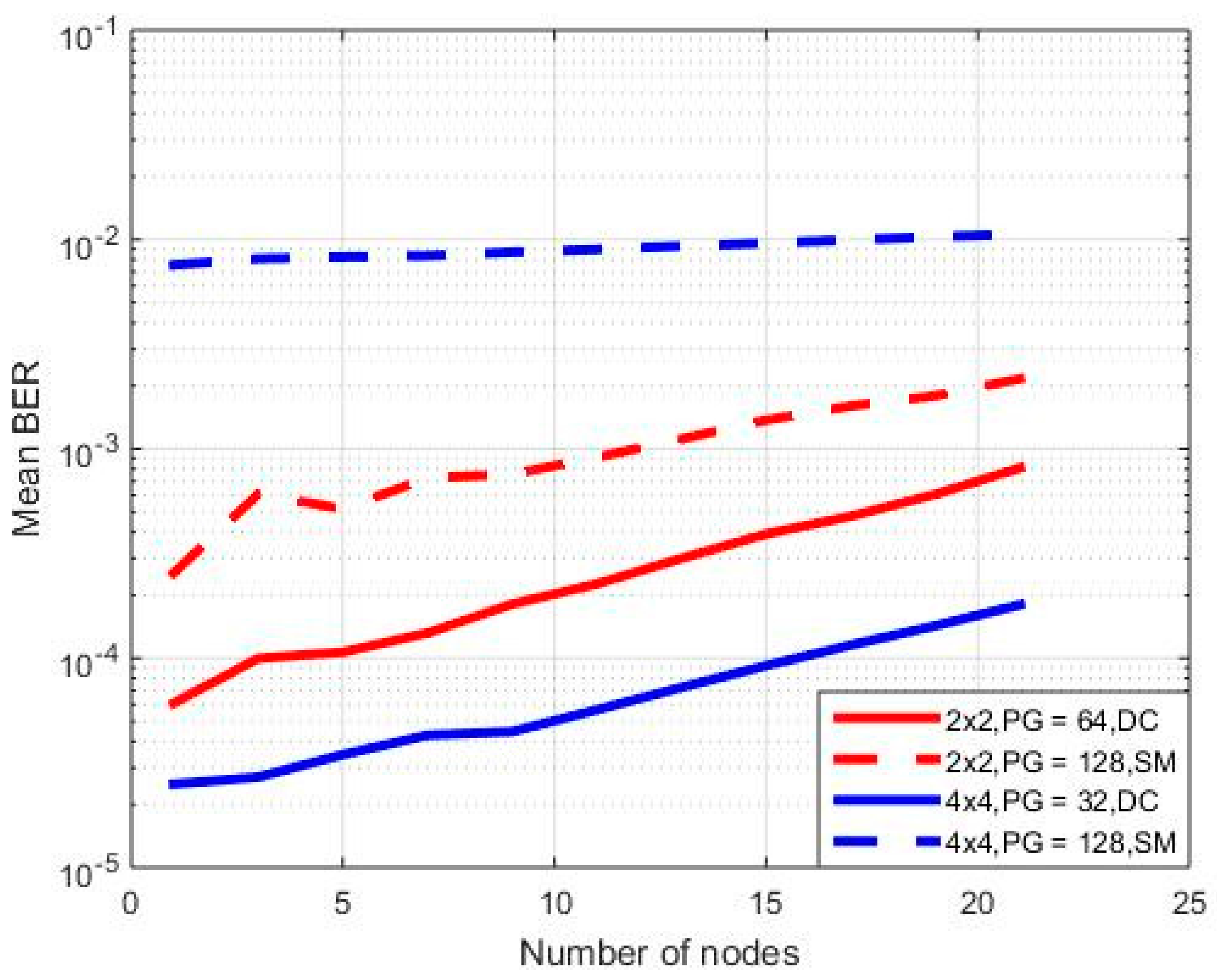1. Introduction
Modern trends in the design of building facilities include minimum energy usage combined with a holistic monitoring of building infrastructures in terms of energy consumption. In this context, not only can consumed energy be reduced but also an environmental framework for energy management can be established in the long term [
1]. This concept is also referred to as building management system (BMS), which includes a variety of diverse operations, from sensing and wireless transmission to decision making procedures and building automations. Typical responsibilities of a BMS include, but are not limited to, video surveillance systems and lighting, monitoring air quality (temperature, humidity, carbon monoxide, carbon dioxide, hydrogen sulfide, ozone, and particles), indicating when the air quality is not proper for living (ventilation), monitoring energy quality and quantity (e.g., current, voltage, active energy, active power, water, and gas), measurements of inside and outside temperature, and humidity measurements [
2].
In the near future, it is expected that BMS protocols and operations will be incorporated in fifth-generation (5G) mobile communications, thus enhancing user experience in smart building management [
3]. In addition, BMSs should also allow bidirectional communication with smart grid (SG) infrastructure [
4,
5] in order to accurately predict energy consumption and demand. Therefore, appropriate BMS deployment requires a reliable network infrastructure able to gather and process information under various conditions. In this context, a well-known and established practice is the deployment of wireless sensor networks (WSNs) on the premises of the building, properly installed in order to measure a variety of values and report back to the central server. Proper installation should take into account minimization of overall transmission power of wireless nodes as well as indoor propagation that can significantly deteriorate signal quality.
Several approaches in recent literature have attempted to provide an insight into modern BMS trends. In [
6], load control and load balancing techniques are investigated, in the concept of artificial intelligence in BMS orientations. In [
7], an initial attempt to create a secure data-centric BMS architecture is presented. To this end, a hierarchical namespace across application data and user identities to simplify user authentication and data access control are presented. In [
8], various protocols are analyzed for BMS applications. The authors conclude that KNX, LonWork, and BACnet protocols [
9] are appropriate for building automation because of their high safety, adaptability with other products, reasonable prices, and simple installation. In the same context, and in order to overcome the heterogeneity of various building protocols, in [
10], the authors propose the Web-of-Things (WoT) framework, using well-known standard technologies of the Web such as HTTP and RESTful APIs, for standardizing the access to devices seen from an application point of view. In [
11], a flexible WoT hierarchical architecture model is presented for the concept of smart cities and aims to interconnect various diverse technologies. In [
12], the BMS concept for buildings with a large-scale automation system is presented. The basic idea was to build a control system database as an extension of the Building Information Modeling (BIM) database, which contains the definition of an automation system and a technological infrastructure controlled by that automation.
Other works have focused on the performance evaluation of communication protocols for wireless sensor networks. In [
13], various medium access control (MAC) protocols for synchronous/asynchronous and single/multi-channel WSNs are investigated. Single-channel MAC protocols are categorized into synchronous and asynchronous approaches, and the advantages and disadvantages of each protocol are presented. In addition, the different features required in multi-channel WSNs compared to single-channel WSNs are investigated as well. In [
14], specific output metrics in WSNs such as optimum distance among nodes as well as transmission power are extracted for the case of non-fading channels, considering specific modulation schemes.
The goal of the work presented in this paper is to investigate the performance of a BMS orientation, where multiple input–multiple output (MIMO)—wideband code division multiple access (WCDMA) transmission and reception is adopted for the communication with network nodes, due to its inherent capability to take advantage of multipath propagation and minimize overall transceiver complexity [
15]. With respect to
Figure 1, each node is equipped with a multi-antenna system and a 2-D space–time rake receiver that estimates and coherently combines multipath replicas of the transmitted signal. Unlike other works with main emphasis in networking protocols and performance analysis considering a fixed node topology, our work not only covers ad-hoc cases but also focuses on the deployment of MIMO architecture in wireless nodes in order to optimize transmission power and improve network performance without additional spectrum requirements. In this context, it is assumed that node locations may vary according to traffic conditions in the building or other external factors; therefore, Monte Carlo (MC) simulations are performed where at each iteration a different network topology is considered. As integration with 5G standardization and SG infrastructure progresses [
16], a physical layer protocol analysis is essential as well, since network nodes will play a dual role: measuring critical parameters and informing the BMS of appropriate actions as previously mentioned, as well as interacting with mobile users in order to provide information on demand.
The rest of this manuscript is organized as follows: In
Section 2, the mathematical framework for wireless transmission in building environments is provided, with emphasis on multipath exploitation, considering a MIMO–3G infrastructure. Indoor propagation is considered, while performance metrics, such as per frame signal-to-interference-plus-noise ratio (SINR) and transmission power, are derived as well. In
Section 3, the simulation framework is provided, while in
Section 4 results are presented for various MIMO orientations (i.e., 2 × 2, 3 × 3, and 4 × 4) and six resolvable multipath components in terms of mean transmission power per mobile node. Finally, concluding remarks and proposals for future work are given in
Section 5.
2. MIMO–WCDMA Orientation
A building orientation with
M floors is considered, with
Mi sensor nodes per floor (1 ≤
i ≤
M). It is assumed that all nodes can communicate wirelessly with the central BMS. This is a rather realistic assumption, since we consider a dynamic environment where all nodes can be placed ad hoc. In order to reduce overall transmission power, each node is equipped with
Mt antennas, the central BS with
Mr antennas, while the WCDMA physical layer protocol has been adopted for internode communications [
17]. In WCDMA, which is already used by mobile terminals in 3G communications, all nodes can transmit simultaneously occupying the whole transmission bandwidth. This is achieved with the use of orthogonal spreading sequences, which multiply the information signal. These sequences have low cross correlation values, thus minimizing unwanted effects from multipath propagation. The transmitted WCDMA signal for diversity combining transmission mode (i.e., the same signal is send and received from all antennas) is given by [
17]
where
pn is the power of the
nth node (1 ≤
n ≤
N),
cn(
t) the coding sequence, and
bn(
t) the information signal.
For
Mt antennas at the transmitter,
wn represents the
Mt × 1 transmission vector that corresponds to the complex power distribution per antenna (i.e.,
= 1, where
is the Frobenius norm of vector matrix
x). It is assumed that
bn(
t) has a symbol duration equal to
T, while the corresponding duration for the coding sequence is
Tc. The ratio
T/
Tc is also called a spreading factor (
SF). In a multipath environment, the received signal from the
Mr antennas of the central BS (considering uplink transmission) will be given by
where
yn(
t) is the
Mr × 1 received signal vector matrix,
L is the number of multipath components and
τl the corresponding delay of the
lth multipath (1 ≤
l ≤
L). Moreover, the term
TL denotes the total losses (i.e., due to pathloss, shadowing, antenna radiation patterns, etc.) from the transmitter to the receiver. Finally,
Hn,l is the
Mr ×
Mt channel matrix, and
nn the
Mr × 1 additive white Gaussian noise. In a rich scattering environment such as the inner of a building, each element of
Hn,l is assumed to be a zero mean complex Gaussian random variable with standard deviation equal to one [
18].
In order to exploit multipath propagation, it is assumed that each node is equipped with
L rake receivers, also called fingers, which estimate the corresponding delay and coherently combine the individual components. The output from each finger will be given by [
18]
In Equation (3), b
n,0 is the symbol at the current time offset, while
bn,−1 the corresponding symbol at the previous time offset. Moreover,
rn,l is the multiplying maximal ratio combining (MRC) vector matrix, given by [
18,
19]
While
ρ and
are the partial cross-correlations of the spreading sequences:
where
is the conjugate of x. The desired signal power will be given by
while multiple access interference (MAI) from the
n’th node (
n’ ≠
n), intersymbol interference (ISI), and noise power will be given by Equations (8)–(10), respectively:
where
No is the thermal noise level. Therefore, overall signal-to-interference-plus-noise ratio (SINR) for the
nth node is formulated as follows:
Depending on channel conditions and network load, capacity is upper limited either by the soft or hard mechanism. Soft capacity is defined as the number of nodes for which the SINR criterion (i.e., SINR > SINRth, where SINRth is a given threshold for a specific type of service) is satisfied without power outage. On the other hand, hard capacity equals to the available number of spreading sequences in a given service area.
Pathloss propagation among different floors is modeled according to ITU-R specifications, where
v is the distance power loss coefficient,
f is the frequency in MHz,
d is the separation distance in meters between the central BS and a mobile node,
Lf(
n) is the floor penetration loss factor in dB, and
n is the number of floors between central BS and mobile node. Considering propagation at 2 GHz, for the considered office environment,
v = 3 and
Lf(dB) = 15 + 4 (
n – 1). Hence, net pathlosses and shadowing effect are calculated as follows [
20]:
where
Xσ is a log-normally distributed random variable corresponding to shadowing effects.
In a realistic mobile environment, uplink or downlink transmission power per node is updated periodically using SINR measurements. In this work, however, as we are mainly interested in capacity limitations stemming from the deployment of MIMO architecture, transmission powers are calculated after linear matrix inversion on the matrices that are derived from the deployment of the equivalent SINR criterion on all nodes. Note that Equation (8) can be alternately written by
Hence, a linear form of equations can be derived for the
N × 1 power vector matrix:
In Equation (14), Matrices
A (
n ×
n) and
B (
n × 1) are given by
where
1(
N) is an
N × 1 matrix of ones.
3. Simulation Framework
In this section, the simulation framework is provided considering a three-floor building with various sensor nodes per floor (
Figure 2). Evaluation is performed with the help of MC simulations, where at each snapshot the nodes per floor can have a different orientation following a uniform distribution. At each snapshot, for every node in the network, the channel coefficient from the central BS is generated for all multipath components, according to the Gaussian distribution as described in
Section 2. As explained, this is a rather realistic assumption, due to the number of reflections that take place inside a building. Once these coefficients are generated, corresponding parameters such as total losses are calculated per node. Afterwards, the matrix formulation according to Equations (14) and (15) takes place and overall transmission powers are calculated.
As it will be explained in the following section, two transmission modes have been considered: diversity combining mode, where, as previously explained, the same information signal is sent and received from all transceiver antennas, and the spatial multiplexing transmission mode [
21]. In the latter case, different information signals are sent from different transmit antennas. In this case,
wn is an
Mt ×
Mt matrix. In both transmission cases,
wn matrices are calculated according to overall signal strength maximization. This iterative procedure is presented in
Table 1 and
Table 2, where tr(
X) is the trace of Matrix
X. In
Table 1,
X(
λm(
A)) is the eigenvector corresponding to the maximum eigenvalue of Matrix
A. In
Table 2,
U and
V are the left and right singular matrices after singular value decomposition (SVD) of Matrix
A, while
Σ is a diagonal matrix containing the eigenvalues of
A in descending order. Moreover,
IK is a K × K identity matrix, and diagonal matrix
D indicates power distribution per transmission mode (tr(
D) = 1). Finally,
dim = min(
Mt,
Mr) indicates the dimension of the MIMO orientation. Both algorithms initially assume a uniform power distribution in all antennas, and at each step the desired signal strength is calculated. This procedure comes to an end once the convergence of both algorithms (defined by parameter
ε) takes place. Finally, all simulation parameters are summarized in
Table 3.
4. Results and Discussion
In
Figure 3,
Figure 4 and
Figure 5, results are provided regarding the mean uplink transmission power of the network nodes to the BS for three MIMO orientations: 2 × 2, 3 × 3, and 4 × 4. Processing gain (
PG) is equal to 128/64/32, while SNR may vary from 3 to 7 dB. In the first set of simulations, the diversity combining transmission mode has been assumed. Hence, for a WCDMA bandwidth equal to 3.84 MHz [
1], the three
PG values correspond to an equivalent transmission rate of 30/60/120 Kbps, respectively.
In each graph, where mean transmission power per node is provided on a vertical axis, notation x,y,z stands for the number of transmit antennas/the number of receive antennas/
PG. As can be observed in
Figure 3, the mean transmission power is higher for the 2 × 2 orientation compared to the other two cases. With 21 nodes per floor and a
PG equal to 128 in the 2 × 2 case, the mean transmission power is 2.08 W. The corresponding values for the 3 × 3 and 4 × 4 cases are 1.185 W and 0.8205 W, respectively. Hence, as the order of the MIMO orientation increases (i.e., the number of transmit and receive antennas), the mean transmission power decreases as expected, while this is also the case for the power reduction rate. Moreover, as can be observed from
Figure 3, the 2 × 2 case is more vulnerable to
PG variations. For
PG = 64, the mean transmission power is 2.23 W, while the corresponding value for
PG = 32 is 2.614 W. Hence, in the first case, we have an increment of 7% compared with the transmission power for
PG = 128, and this increment further increases to almost 26% in the second case (i.e.,
PG = 32). When more antennas are added at both ends of the MIMO link, this increment is significantly lower, especially in the 4 × 4 orientation. In this case, for
PG = 32 and one node per floor mean transmission power is 0.8159 W. For 21 nodes per floor, then this value increases to 0.8944 W. The corresponding values for the 2 × 2 case are 1.944 W/2.614 W, respectively. Hence, as the number of nodes increases, the MIMO order should be increased as well in order to calibrate transmission power increment.
In
Figure 4 and
Figure 5, the results corresponding to
Figure 3 are presented for SNR = 5 dB and SNR = 7 dB, respectively. As can be observed in
Figure 4, in the 2 × 2 case, the power gap among transmissions with
PG = 128 and
PG = 32 increased. For 21 nodes in the network, in the first case, the mean transmission power is 2.614 W, while in the latter case, it is 5.184 W; hence, there is an increment of almost 100%. In the 4 × 4 case, the corresponding transmission power is 0.8944 W/1.522 W for
PG = 128/32, respectively. Hence, power increment is now 70%. Similar conclusions can be drawn from
Figure 5 as well. Note, however, that in the 2 × 2 case there is a severe power outage for 21 nodes in the network. In all sets of simulations, no power thresholds were set, as the main goal was the performance evaluation of all MIMO orientations in extreme scenarios.
In
Figure 6, results are provided for the case of antenna selection (AS) at mobile nodes. In this case, it is desirable to select a subset of transmit antennas in order to reduce RF complexity, at the cost, however, of increased transmission power. In the considered simulation scenario, a 4 × 4 MIMO transmission scenario has been considered with three cases: No AS, two selected antennas, and three selected antennas. Note that in the latter two cases, a subset of antennas is selected that maximizes the received SNR over all multipath components; hence,
where
Sn is the set of transmit antennas for the
nth node,
Hn,j,l is the equivalent channel matrix considering transmission from the antennas in the subset
j, and the set
TR includes all possible combinations of transmit antennas. For example, considering a use case scenario with two selected transmit antennas,
TR = {(1,2),(1,3),(1,4),(2,3),(2,4),(3,4)}.
As can be observed from
Figure 6, as expected, transmission from all antennas is the best solution in terms of radiated transmitted power. For 21 nodes, when selecting three transmit antennas, the mean transmission power is almost 0.97 W, while the corresponding value for two transmit antennas is 0.89 W. Hence, compared to the case where no AS takes place, in the case of three transmit antennas, we have a power increment of almost 9%, which increases to 19% for the case of two transmit antennas. Note that AS burden is transferred to the BMS central BS, which gathers and processes all channel coefficients and then informs via feedback signals all nodes for the appropriate selection of transmit antennas.
In the final set of simulations, the spatial multiplexing transmission mode was considered. For a fair comparison with the previous cases of diversity combining, it is assumed that the input powers of the spatial multiplexing simulator are the ones that have been calculated at the diversity combining transmission mode, properly weighted. In this context, in the first case, a 2 × 2 MIMO orientation has been considered, while PG equals 64 in the diversity combining case and 128 in spatial multiplexing transmission mode. Note that, in both cases, the equivalent transmission rate is 60 Kbps, as in spatial multiplexing two different input streams are sent from the transmit antennas. In the second case, simulations are repeated for a 4 × 4 MIMO orientation, where now PG equals 32 in the diversity combining case and 128 in spatial multiplexing transmission mode.
Results are presented in
Figure 7, where mean bit error rate (BER) is plotted on a logarithmic scale for the aforementioned cases (DC stands for diversity combining and SM for spatial multiplexing. Details on theoretical BER calculations for spatial multiplexing transmission are provided in the
Appendix). Note that, in this particular set of simulations, an SNR of 10 dB has been considered and a building orientation with one floor. Mobile nodes may vary from 1 to 21, as in the previous set of simulations, with a step of 2. Finally, the power per node in the spatial multiplexing cases (2 × 2 and 4 × 4) has been set to be double the value of the corresponding power in diversity combining mode for a 1 × 2/2 × 4 MIMO system, respectively, as now the diversity order of the system is reduced to half. As can be observed in
Figure 7, in all cases of mobile nodes, spatial multiplexing transmission worsens the mean BER. This result is rather expected, as spatial multiplexing can be severely affected both by MAI and multiple reflections in indoor environments [
22]. Note that BER in SM is affected to a greater extent in the 4 × 4 MIMO case, as MAI is the main capacity limiting factor due to the multiple antennas. This particular simulation scenario with four different input streams corresponds to four independent diversity combining cases (i.e., 1 × 4). Therefore, each receive antenna now undergoes a greater amount of interference, as it receives
Mt ×
L independent signals. Hence, diversity combining is the most appropriate solution for this type of communication, especially if we are interested in low-rate communications.
5. Conclusions
The performance of a MIMO–WCDMA architecture inside a building environment was analyzed. Two transmission modes (diversity combining and spatial multiplexing) were considered along with various amounts of nodes in a three-floor building. For each simulation scenario, a sufficient number of independent MC simulations were carried out for different MIMO orientations. According to the presented results, diversity transmission can improve the overall performance of the proposed approach, considering a multipath environment. In this context, high data rates along with an increased number of mobile nodes can be supported by increasing the order of the MIMO configuration. On the other hand, spatial multiplexing is not an efficient solution, as this type of transmission can be severely affected by multiple access interference. In contrast to wireless cellular networks, the number of nodes in indoor BMSs is known a priori. Therefore, for a specific uplink power threshold and transmission rate, an appropriate MIMO deployment can be selected, based on the extracted parametric curves (i.e., power versus nodes, SNR, number of transmit/receive antennas, antenna selection, transmission mode, etc.).
Ongoing work includes alternate transmission scenarios, such as the use of relay nodes and a cross-layer approach to interconnect the presented architecture with Internet of Things technology.
